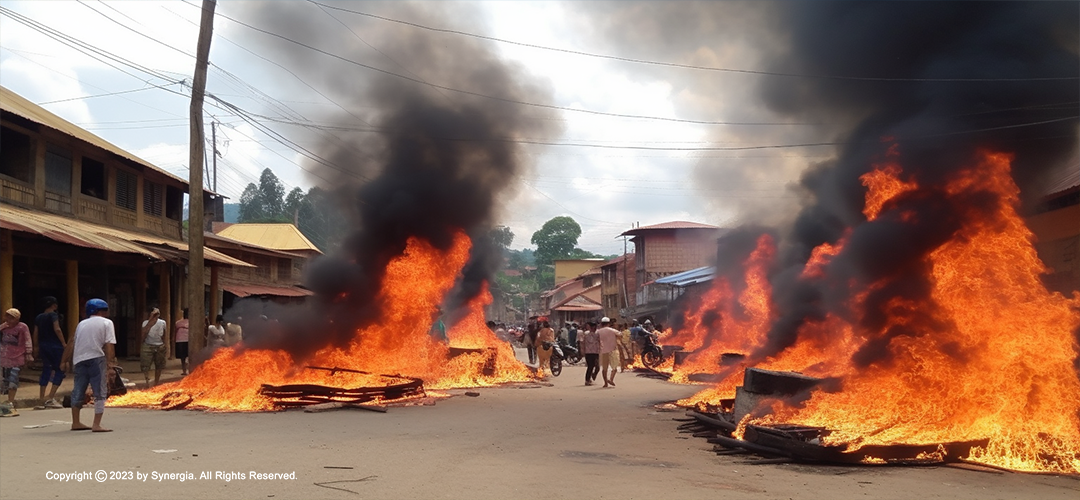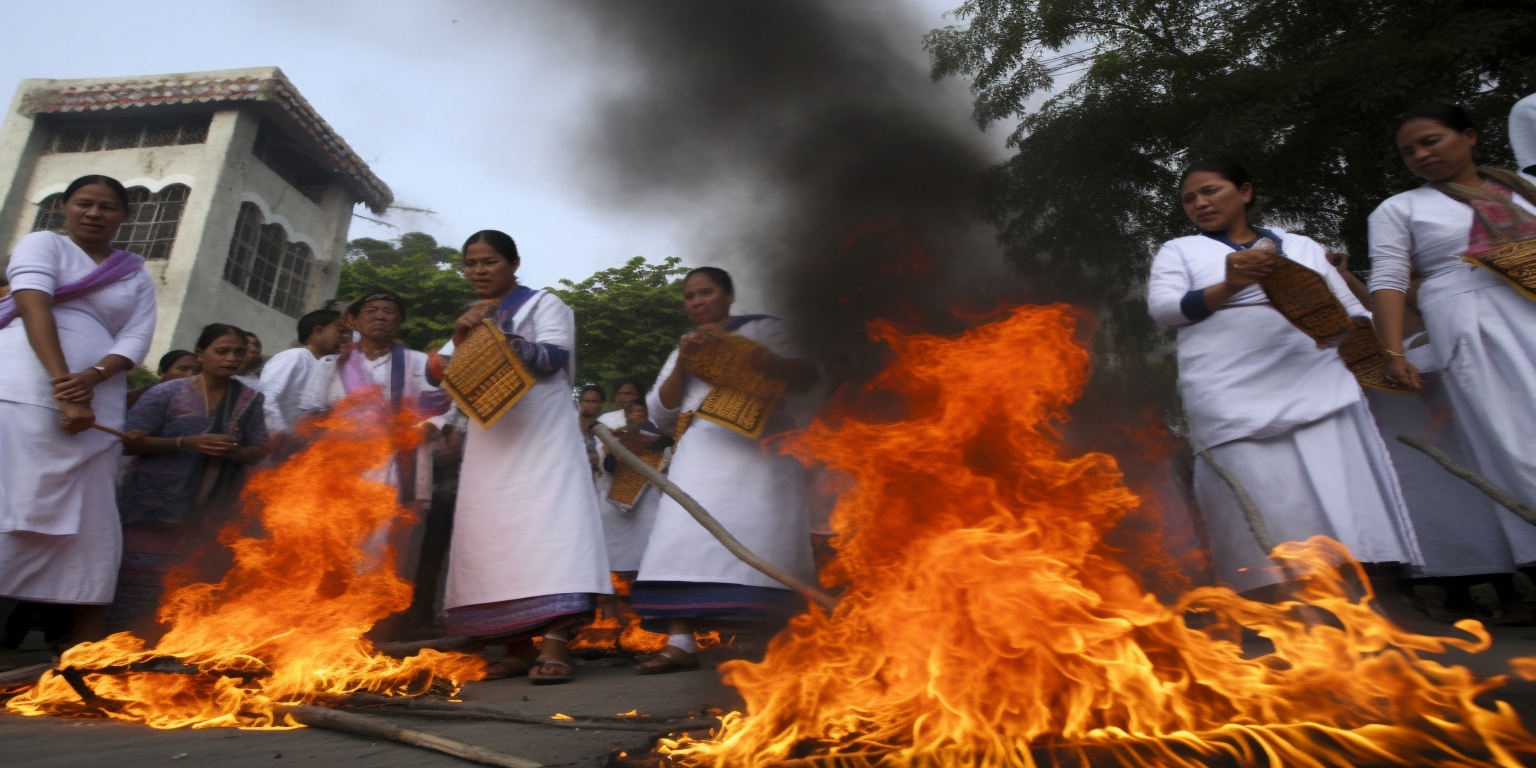Why is Manipur Burning?
May 12, 2023 | Expert Insights

As the Indian Army patrols the streets of Manipur, empowered with authority to 'shoot at sight', going door to door rescuing trapped inhabitants marooned in townships controlled by rival ethnic groups and fearful of violent reprisals, the rest of the country looks aghast at the mayhem.
While the trouble had been simmering below the surface for some time, the national media was too caught up in mainline stories to spare any attention for this small but crucial state in the Northeast, hence the shock and the universal horror at the senseless death and destruction. During a year when India has been showcasing itself to the SCO and the G20, the rank violence did not make a good copy.
The tipping point came on May 3rd when incensed at the decision of the Manipur High Court, the All-Tribal Students' Union, Manipur (ATSUM) called a Tribal Solidarity March in the Torbung area of Churachandpur. The march quickly degenerated into an orgy of arson and violence.
Background
The violence is coming to the fore of the traditional competition between the various tribal entities that make up this beautiful state in the North-eastern corner of India.
The Meitei community is the majority in Manipur, making up 53 per cent of the state’s population and occupying the fertile valley area. An assortment of Naga (24 per cent) and Kuku /Zomi (16 per cent) tribes reside partly in the valley but majorly in the forest-covered hills ringing the valley.
Religion is also a factor, as the Meitei are mostly Hindus with a mixture of Muslims and Christians. On the other hand, the bulk of the non-Meitei tribals are Christians.
Under pressure from the Centre, the state government's wildlife preservation departments have been engaged in securing protected areas of forest land and wetlands from illegal tribal settlers, who historically have enjoyed the freedom to tap on the forest wealth for their survival. As per the tribal groups, many churches were demolished during the eviction drive, sparking outrage amongst the Christian Kukis and Nagas, which their leaders could effectively channel to create the consequent mayhem.
The eviction drive added to the friction between the tribals and the Meitei-dominated state government organs. The infuriated tribals, spearheaded by the Indigenous Tribal Leaders' Forum (ITLF), promptly burnt down a newly constructed open gym that was scheduled to be inaugurated by the chief minister, Mr Biren Singh.
Justifying the eviction drive from reserved forest areas and wetlands, the All-Meitei Council claims that the eviction drive was not targeted at anyone tribal community, but all areas of illegal encroachments, whether by the Meitei or Muslims or Kuki, were addressed.

Analysis
The latest move that caused the water to boil over was the decision by the Manipur High Court of March 27th directing the Manipur state government to submit recommendations to the union government for the inclusion of Meitei in the ST list. There are 34 subtribes of the Nagas and Kuki-Zumi, all in the Scheduled Tribes list.
Granting Scheduled Tribe (ST) status to the majority Meitei community brings them into direct competition with the non-Meitei tribals (who already enjoy this status) for the rapidly diminishing government jobs and the limited seats in government controls educational institutions for the reserved categories.
This has to be viewed through the prism of the rapidly changing demography of the state. The hill areas of Manipur have experienced an abnormally high rate of population growth, which Meitei are attributing to the illegal immigration of Kuki people from Myanmar into the forest land of Manipur, abetted by the local Kuki community.
The tribal groups - a majority being Kuki groups - protest that the eviction and survey are in violation of Article 371C of the constitution, which provides some administrative autonomy to the tribal communities occupying the hill areas of Manipur.
The Meitei are the more predominant group in Manipur, wielding political and administrative power. They constitute 53 per cent of the entire population of the state but occupy only 10 per cent of the land of Manipur, as the rest of the state is classified as tribal areas and can only be bought by those classified as Tribals.
The Meitei community had Scheduled Caste status before 1949 but lost this when the state merged with India in that year, reportedly because they are considered caste Hindus. They currently fall under the OBC category, providing them opportunities to occupy government or public sector seats in higher education institutions within the reservation allotted to this category. In Manipur, the quota for STs is 31 per cent, OBCs 17 per cent and SCs 2 per cent.
The Meitei community considers itself at a grave disadvantage at being unable to expand its land holdings within areas earmarked for the tribals (90 per cent of the land) while the tribals are free to purchase land in the non-tribal areas (10 per cent). Unsurprisingly, the competition for land has become extremely acute.
According to the Meitei, they will lose the status of an indigenous community without that of an ST status and to safeguard their ancestral lands, culture and identity, perceived to be under threat from an influx of illegal immigration from Myanmar and outside the state.
Defending their demand for restoration of their tribal status, the Meitei, despite being staunch Hindus, point to their unique ancient rituals, their mongoloid origins and their geographical isolation from the Indian mainland, which has made them economically backwards in comparison to the national average.
The tribal groups state that the Meitei are already a majority and dominating community in the state, pointing out that 40 of 60 MLAs are from the Meitei community. Also, they have been doing reasonably well even as an OBC and enjoying immense political patronage. If granted ST status, they would quickly spread out into tribal land and create a new set of conflicts in the surrounding hill areas.
However, within the tribals themselves, there is a difference of opinion.
While the Naga tribes also oppose the Meitei demand for ST status, this community has distanced itself from the recent outbreak of violence in the state. The Tribal Solidarity March took place throughout the state but remained peaceful in Naga areas.
Several organisations of the Naga community have also stated that the ITLF is new and does not represent all tribals. The Rongmei Naga Council Manipur issued a statement, clarifying that the actions of ITLF are against the wishes of the indigenous tribes, “The indigenous Rongmei people clarify once, and for all that, it has no knowledge of the existence of such bogus forum and appeals all right-thinking indigenous communities to abstain from the said rally."
The Kukis and Nagas have also demanded the extension of the sixth schedule into the hill areas but received opposition from the Meiteis. Implementing the Sixth Schedule of the Constitution would allow these groups autonomy in their respective areas while they remain within the authority of the State of Manipur.
This is a system of administration that would allow tribal areas to become more developed and protect these communities from exploitation, as well as preserve their social customs.
The United Committee, Manipur (UCM) fears this may create a greater hill-valley divide in the state.
Angered by the delay by the SPF (Secular Progressive Front) government, the Sixth Schedule Demand committee decided to instead support the All-Tribal Students' Union, Manipur (ATSUM)’S demand for a separate union territory, carving out the five hill districts from the state.
Assessment
- Plagued with an insurgency that has lasted over half a century, the fragile state of Manipur cannot be allowed to drift into anarchy and lawlessness. This will have a tendency to spread instability into other regions of the Northeast, where already the political quilibrium and law and order are delicately balanced.
- The Centre has to step in quickly, not only by rushing in Central forces to quell the riots but with more meaningful political and regulatory measures to convince all parties that, ultimately, peace is the only way forward for employment and prosperity for everyone across the tribal divide.








Comments